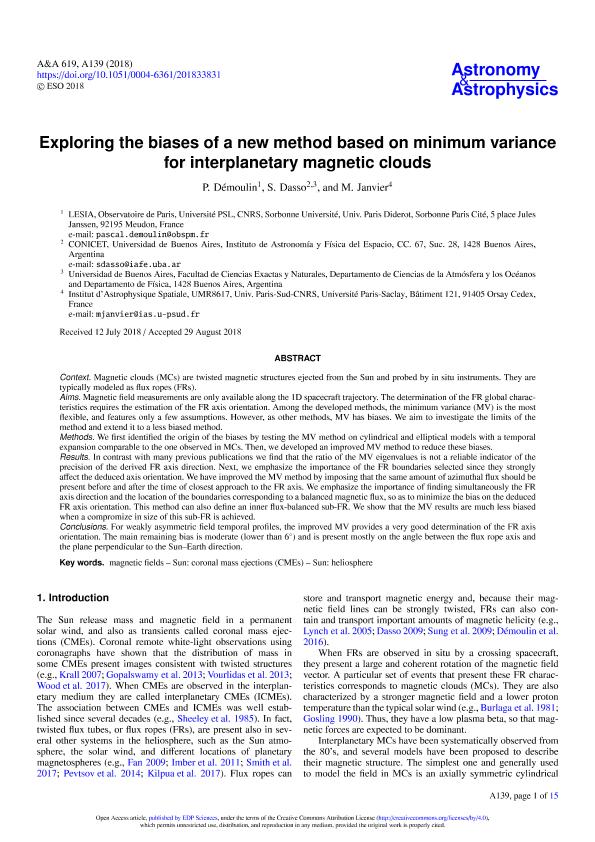Mostrar el registro sencillo del ítem
dc.contributor.author
Démoulin, Pascal

dc.contributor.author
Dasso, Sergio Ricardo

dc.contributor.author
Janvier, M.
dc.date.available
2019-07-31T14:39:29Z
dc.date.issued
2018-08
dc.identifier.citation
Démoulin, Pascal; Dasso, Sergio Ricardo; Janvier, M.; Exploring the biases of a new method based on minimum variance for interplanetary magnetic clouds; EDP Sciences; Astronomy and Astrophysics; 619; 8-2018; 1-15
dc.identifier.issn
0004-6361
dc.identifier.uri
http://hdl.handle.net/11336/80654
dc.description.abstract
Context. Magnetic clouds (MCs) are twisted magnetic structures ejected from the Sun and probed by in situ instruments. They are typically modeled as flux ropes (FRs). Aims. Magnetic field measurements are only available along the 1D spacecraft trajectory. The determination of the FR global characteristics requires the estimation of the FR axis orientation. Among the developed methods, the minimum variance (MV) is the most flexible, and features only a few assumptions. However, as other methods, MV has biases. We aim to investigate the limits of the method and extend it to a less biased method. Methods. We first identified the origin of the biases by testing the MV method on cylindrical and elliptical models with a temporal expansion comparable to the one observed in MCs. Then, we developed an improved MV method to reduce these biases. Results. In contrast with many previous publications we find that the ratio of the MV eigenvalues is not a reliable indicator of the precision of the derived FR axis direction. Next, we emphasize the importance of the FR boundaries selected since they strongly affect the deduced axis orientation. We have improved the MV method by imposing that the same amount of azimuthal flux should be present before and after the time of closest approach to the FR axis. We emphasize the importance of finding simultaneously the FR axis direction and the location of the boundaries corresponding to a balanced magnetic flux, so as to minimize the bias on the deduced FR axis orientation. This method can also define an inner flux-balanced sub-FR. We show that the MV results are much less biased when a compromize in size of this sub-FR is achieved. Conclusions. For weakly asymmetric field temporal profiles, the improved MV provides a very good determination of the FR axis orientation. The main remaining bias is moderate (lower than 6°) and is present mostly on the angle between the flux rope axis and the plane perpendicular to the Sun-Earth direction.
dc.format
application/pdf
dc.language.iso
eng
dc.publisher
EDP Sciences

dc.rights
info:eu-repo/semantics/openAccess
dc.rights.uri
https://creativecommons.org/licenses/by-nc-sa/2.5/ar/
dc.subject
Magnetic Fields
dc.subject
Sun: Coronal Mass Ejections (Cmes)
dc.subject
Sun: Heliosphere
dc.subject.classification
Astronomía

dc.subject.classification
Ciencias Físicas

dc.subject.classification
CIENCIAS NATURALES Y EXACTAS

dc.title
Exploring the biases of a new method based on minimum variance for interplanetary magnetic clouds
dc.type
info:eu-repo/semantics/article
dc.type
info:ar-repo/semantics/artículo
dc.type
info:eu-repo/semantics/publishedVersion
dc.date.updated
2019-07-29T14:51:21Z
dc.journal.volume
619
dc.journal.pagination
1-15
dc.journal.pais
Francia

dc.journal.ciudad
Paris
dc.description.fil
Fil: Démoulin, Pascal. Lesia - Laboratoire D'etudes Spatiales Et D'instrumentation En Astrophysique;
dc.description.fil
Fil: Dasso, Sergio Ricardo. Consejo Nacional de Investigaciónes Científicas y Técnicas. Oficina de Coordinación Administrativa Ciudad Universitaria. Instituto de Astronomía y Física del Espacio. - Universidad de Buenos Aires. Facultad de Ciencias Exactas y Naturales. Instituto de Astronomía y Física del Espacio; Argentina
dc.description.fil
Fil: Janvier, M.. Université Paris Sud; Francia
dc.journal.title
Astronomy and Astrophysics

dc.relation.alternativeid
info:eu-repo/semantics/altIdentifier/doi/http://dx.doi.org/10.1051/0004-6361/201833831
Archivos asociados
